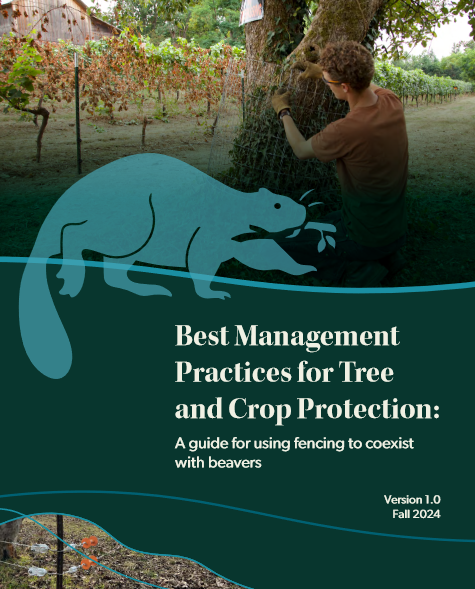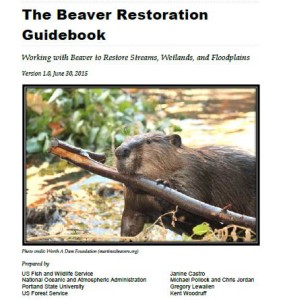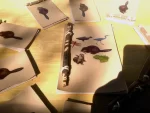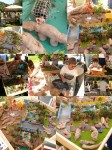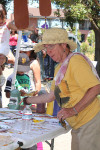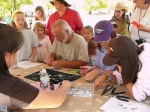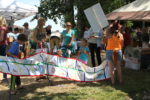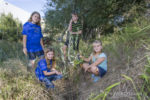Last night’s evening at Madrone Audubon in Santa Rosa was a dynamic reminder that people who take their birds seriously are ready to talk about beavers. We were warmly welcomed and Brock started with a perfect overview of the beaverdom in California situation. My very favorite part was where he was talking about a friend’s plan on the Klamath to install a dam in one stretch of land to make some wetlands and fish habitat, but the friend’s intention was daunted by permitting and funding.
Never mind. Some unfunded unpermitted hard working beavers moved in, made the dam in that exact spot (plus 19 others) made a luscious slow wetland out of the area that turned into pools and pools of coho salmon – the only salmonids on the river!
Then it was time for Heidi’s beaver story and footage. Goodness they were just the right crowd for a beaver tale! I started with Art’s fantastic footage of the woodpecker in the beaver chew because I thought it anchored the whole presentation for Audubon and then launched into the always compelling story of the Martinez beavers and the effect they have had on our creek here in town.
Afterwards there was a lot of energy and enthusiasm, a couple of folk asked for directions so they could come see the beavers themselves, and a man who asked me if I’d be willing to present to his city council so that they’d be ready when beavers came to their town. Of course I said yes! Why just look how popular Worth A Dam is with our city council?
That was so much fun! So many people commented that the combo of both our presentations was great!
I loved all of your stories and the video of the beavers is so deeply heartwarming and connecting. Love watching mom on her hind legs carrying material! Susan said he thought it was the best evening set of presentations for Audubon ever!
Saturday I just did a TEDx talk in the mission in SF. I think that you should be invited to do a TEDx talk with your show – although it is a tight 18 minutes – it would be so great to have you telling that story on the TED format! Just a thought…
Go Beavers Go Brock
Not quite sure TED is ready for beavers, but when they are they know how to find me! Now some broader beaver news to get you started on your Tuesday. First this fine report of manmade wetlands installed to cover up some monster pollution in Toronto.
Hamilton builds man-made wetland
“It’s not every day that someone builds Great Lake coastal wetland,” engineer and project manager John Helka told the amassed crowd. “It should be a beautiful area in the next five to ten years.”
He says this with some optimism, as the area hasn’t been beautiful in decades. It had been abused by chemicals, sewage overflows, landfill leaks and eroded sediment for years. The harbour became so busy in the ’50s that the basin was converted into a sediment trap to protect it. It was all downhill from there. “It has taken decades to screw up the harbour as bad as it is,” said Bay Area Restoration Council Executive Director Chris McLaughlin. “Steel Mills didn’t happen overnight.” He’s not kidding. Hamilton Harbour is also home to the turgid Randle Reef, the worst coal tar contaminated site in Canada.
So folks have polluted the watershed for years and now they’re spending a ton of money to cover it up. Pile dirt on poison and pour water over it and that’s a lake right? “As one would expect, this isn’t a cheap project. Costs run in the $20 million range, with $13.8 million of that coming from the federal and provincial government. The city is kicking in the rest.” The mind reels. The jaw drops. They’re keeping those pesky migratory birds away so that its easier to work, but this is the part that made me chuckle:
Then there are the beaver fences. Seems that once beavers end up in the wetland, they’ll try to dam up the water spouts for the pumps — so fences had to be constructed to keep the little buggers out.
Yes, you better keep those hardworking buggers out, because otherwise they’ll sneak in and build all those wetlands for free! Then you’d be stuck with that 20 million dollars burning holes in your pocket! You wouldn’t want that to happen would you?
Not when its turning out so nice!
_____________________________________________________________
Need to rinse that bad taste out of your mouth? How about taking a sip of this lovely article on fly-fishing beaver ponds from author and journalist Steve Raymond.
Those wary, demanding trout are one reason I still enjoy fishing beaver ponds. But there are plenty of other reasons. In my backyard, on the wet side of the Pacific Northwest, beaver ponds have their own peculiar haunting beauty. Under dark, rain-swollen skies, they glisten like obsidian; during rare moments of sunlight, their acid-stained waters light up with the color of strong, bitter ale. They exude a scent of mustiness and decay that’s perfectly in character with their gloomy aspect.
Nice writing Steve! What a lovely description of the beaver pond that is practically a portal to another world where nature thrives and changes, and fish have choices so they might not be as desperate as one is used to!
Of course the Pacific Northwest has no monopoly on beaver ponds. They can be found wherever there is cold, running water, lots of trees, and a population of eager beaver. I imagine they all offer similar fishing. But beaver ponds have not fared well in the face of metastasizing suburbs; many have been drained, bulldozed, filled in, or artificially landscaped to provide centerpieces for tasteless “developments.” Others, yet beyond the reach of subdivisions, have been spoiled by logging. So there aren’t as many beaver ponds as there used to be.
But there still are some good ones left—dark little jewels of water hidden back in the woods, filled with dark little jewels of trout. If you make the effort to find them and fish them, I promise you won’t be disappointed. Well, not all the time, anyway.
You know what would be a really effective way to get more beaver ponds? Go ahead, I’ll give you a minute.















